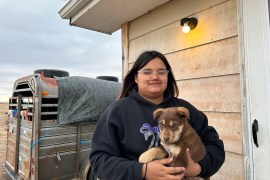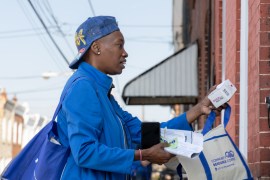Southern Discomfort — Coping With HIV/AIDS In The South Poses Challenges
The eye of the HIV/AIDS storm has shifted to the South, where coping with the epidemic may be tougher than anywhere else in the country.By Lani Luciano
Each Monday, medical staff from the University of North Carolina board a small plane to fly from Chapel Hill to the HIV/AIDS clinic in Lumberton, 115 miles away. The brief flight spares physicians and other professionals with limited, expensive time a five-hour round trip by car to remote southeastern Robeson County. For the clinic's several dozen patients, however, a long commute is often unavoidable. To get to Lumberton from their homes deep in the area's abundant wetlands, many drive an hour or more along rough country roads that twist through the swamps. When they have no cars -- often the case in this desperately poor region -- public health workers make the long trips to pick up, deliver and return them home.
The costly arrangements needed to bring health services to HIV/AIDS patients in Robeson County are something the fund-strapped public health department can scarcely afford. But it has little choice. Like other states, North Carolina's medical resources are clustered mainly in urban centers. Yet 40% of its population lives in rural areas, according to the most recent census data, as do 40% of the residents of South Carolina, 44% in Kentucky and more than half in Mississippi and West Virginia.
A health infrastructure that makes it hard to connect many HIV-positive people with the medical care they need is just one factor in the growing crisis of HIV/AIDS in the South. A report on the impact of the epidemic by region compiled by the Kaiser Family Foundation shows that while the estimated number of new AIDS cases in the United States rose by 1% between 2000 and 2001, it shot up by 9% in the 16 states* (plus Washington, D.C.) that comprise the South in Centers for Disease Control and Prevention (CDC) statistics. During the same period, the Midwest had a 2% increase and the Northeast and West experienced declines. Only 36% of the U.S. population lives in the South, but 40% of all people living with AIDS and 46% of newly identified cases now live in the region. "And statistics are always five years behind where the epidemic is headed," warns Peter Leone, medical director of the HIV/STD Prevention and Care Branch of the North Carolina Department of Health and Human Services.
Although the Southern epidemic has much in common with the national one -- disproportionately affecting minorities, the disadvantaged and men who have sex with men (MSMs) -- dealing with HIV/AIDS in the South means confronting indigenous issues that create unusually high barriers to change. Among them:
-
The country's highest rate of sexually transmitted diseases -- Numerous studies have documented the considerable role that other STDs play in worsening an individual's susceptibility to HIV infection and accelerating its progress. In 2000, the 10 states with the highest rates of gonorrhea were all in the South, as were nine of 10 states with the highest rates of infectious syphilis and seven of 10 with the highest rates of chlamydia. As with HIV/AIDS, widespread testing for and treatment of such STDs is inhibited by regional issues.
-
Racial disparities -- Although Latinos account for a significant part of the Southern population living with HIV/AIDS, particularly in Florida and Texas, African Americans have been hardest hit. They make up 19% of the region's total population but an estimated 53% of those living with HIV/AIDS, compared to 47% nationally. Across the country, minority access to health services is often restricted by lack of insurance coverage and provider biases, issues documented most recently by the Institute of Medicine's 2002 report "Unequal Treatment." In the South, however, access is further impeded by a rural population distribution and a history of segregated health services that produced a durable mistrust of the medical system among many African Americans.
-
A culture that discourages openness about sex -- "It's perfectly legal to teach sex education in Louisiana schools," observes state Sen. Paulette Riley Irons (D), "but only one of our 66 parishes actually does. We don't like to talk about it." The shame and stigma attached to a disease that many Southerners connect mainly with behaviors deemed objectionable, such as homosexuality and extra-marital sex, discourages many people from being treated -- or even tested -- for HIV/AIDS, lest their neighbors find out. The result: an ever-widening network of infected people.
-
Migration -- Reports are anecdotal at the moment but evidence is increasing that HIV/AIDS patients from other regions are coming, or returning, to the South in search of cheaper, warmer living and, in some cases, family reunification. "I-95 has become a pipeline to our services," says Mary Ann Green of Florida AIDS Action, a Tampa community organization. JoAnn Lafontaine of South Carolina's Bureau of Disease Control STD/HIV Program and Ronald Brabson of the Tennessee Association of People with AIDS have observed the same trend. Brabson gets several out-of-state calls a week asking him to explain his state's benefits. "People move North looking for better opportunities but when they get sick, they want to come home," adds Lafontaine.
The problem, say these experts, is that allocation of critical funding for HIV/AIDS services through the Ryan White CARE Act is based in part on where AIDS cases are first reported, not where people eventually settle. Without changes in funding formulas, they say, the South's magnetism could contribute to an already strained health services system. At least one state, Florida, has begun gathering migration data to build its case for more federal money.
Aggressive intervention -- requiring strong leadership -- is needed to head off a developing world-style catastrophe in the South, warns former Surgeon General and CDC director David Satcher, now head of the National Center for Primary Care at Morehouse College's School of Medicine in Atlanta. "The gap between what we know and what we do is large and getting larger," Satcher says. At the moment, however, domestic concerns about bioterrorism have diverted attention and new public health dollars away from HIV/AIDS. Although federal spending in 2002 is expected to total $14.7 billion -- 59% of it for health care and support services, according to a Kaiser Family Foundation report -- White House budget recommendations for fiscal year 2003 include no additional funding for domestic, discretionary programs.
States are unlikely to pick up the slack. The economic downturn has left most unprepared to augment public health coffers, and local statutes prohibiting deficit spending may even force budget cuts. In North Carolina, the waiting list for the AIDS Drug Assistance Program, which provides treatment to uninsured and underinsured patients, closed early this year, opened again after additional funds were located, then closed again on Oct. 4. It's uncertain when, or even whether, registrants after that date will receive treatment. Alabama, Kentucky and Texas also have waiting lists or other restrictions as of October.
Focusing government attention on the marginalized requires talking to legislators in terms that interest them, counsels Louisiana's Riley Irons. She says, "Legislators care mainly about three things: votes, contributions and saving budget dollars for their own causes." To make the case for funding HIV/AIDS services, says Beth Scalco, director of Louisiana's HIV/AIDS Program, "We have to make it clear that getting people into treatment is the only way they're going to be able to support their families." In mid-November, the National Alliance of State and Territorial AIDS Directors and the Kaiser Family Foundation co-sponsored a conference on the impact of HIV/AIDS in the South, during which NASTAD members from Southern states collaborated on a "manifesto" pressing legislators, policymakers, the media and interested citizens to address the crisis. "To be committed to change, we've got to be committed to political action," says Evelyn Foust, head of the HIV/STD Prevention and Care Branch of North Carolina's health department.
Meanwhile, in meaningful if modest ways, community-based organizations are working hard to influence hearts and minds. Renaissance III, a gay men's advocacy group in Dallas, has established permanent beachheads in four of the city's gay nightclubs. Patrons can get referrals for STD screenings on the spot. "Just as important," points out Don Sneed, an activist who works with Renaissance, "we're building a supportive community for people who don't have one." The Interfaith Community AIDS Resource and Education Coalition in Columbia, S.C., distributes paper fans to small rural churches that may lack air conditioning in steamy summer months. Printed on one side is a Biblical admonition not to despise or disdain the afflicted (Psalm 22:24). On the other side are names and phone numbers of local health agencies and HIV/AIDS support groups.
*Ala., Ark., Del., Fla., Ga., Ky., La., Md., Miss., N.C., Okla., S.C., Tenn., Texas, Va., W.V.
Lani Luciano is a writer specializing in health policy and economics. Her work has appeared in Barron's, Money, Business and Health and other magazines.
This report is the 14th in kaisernetwork.org's series on emerging and underreported issues in HIV and reproductive health, which is available online. This is part of the Morning Briefing, a summary of health policy coverage from major news organizations. Sign up for an email subscription.






